As they say, it’s not the size of it but how you use it that counts and that comes to mind when thinking of my new workbench, because I’ve opted to build it 12′ long!
I knew fairly quickly that I’d build my new workbench in the English style and I’d also been toying with the idea that I’d like to have two workbenches rather than just the one. This English bench will mainly be intended as a prepping and assembly bench and I’m really looking forward to showing how it will be suited to that, and used alongside another. Two workbenches is a complete and utter luxury and it’s not something which I’d ever say you need but in this workshop this bench is going to be my equivalent of the rip saw, planer and thicknesser.
Now for that second extravagance, the length.
12′ was never part of my plan but then I received the timber delivery and each board was clearer than most pine you get to see and amazingly straight and free from twist. It was going to be a shame to cut them down short and I realised that at full length the bench would slip perfectly in to the available space. The final excuse I gave myself was our barn restoration, and a 12′ bench would be an enormous aid when building very large doors, lengths of moulding and even trusses. So I couldn’t really find a reason why not to build it 12′ long! 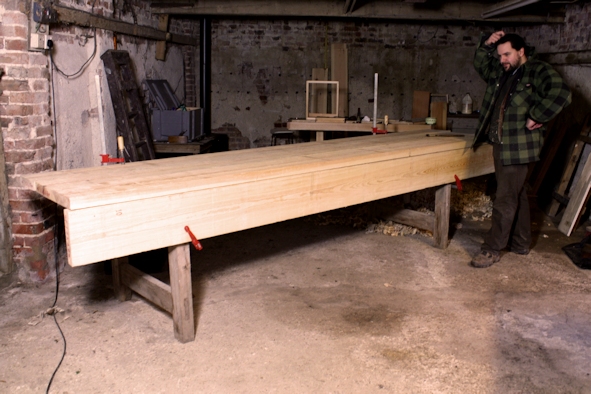 Overall I’ve got to build this workbench with my own needs and purposes at the fore front but I’ll also be putting a heavy emphasise and going to extra lengths to show how you can build a solid workbench using only hand tools.
Overall I’ve got to build this workbench with my own needs and purposes at the fore front but I’ll also be putting a heavy emphasise and going to extra lengths to show how you can build a solid workbench using only hand tools.
If you’re new to woodworking or just to hand tools then with any large build you’re planning you want to be sure that the design is a sensible match to your tools and experience. This is going to mean no laminations in the top, in fact there’s no gluing up for the top at all. And with the joinery I’ve opted out of having any massive mortice and tenons to cut by hand (the trestles in the photos are ones I found to prop the top to, not the ones I’ll be using). I get asked a lot of questions about workbench builds and for beginners in particular it seems like the prospect of many large mortices can be a bit daunting. I think this comes down to limited time more than anything and if you have only got a few hours each weekend to get in to the workshop and it almost takes you that to cut one maybe two large joints then having up to 12 to do could feel a bit endless. I don’t wish to put anyone off the mortice and tenon but I thought it would be interesting to show an alternate joint; one which can look attractive and be very strong for this purpose, but is much quicker when only using hand tools. I think in a couple of weekends anyone just setting out with their hand tools could have this knocked up. 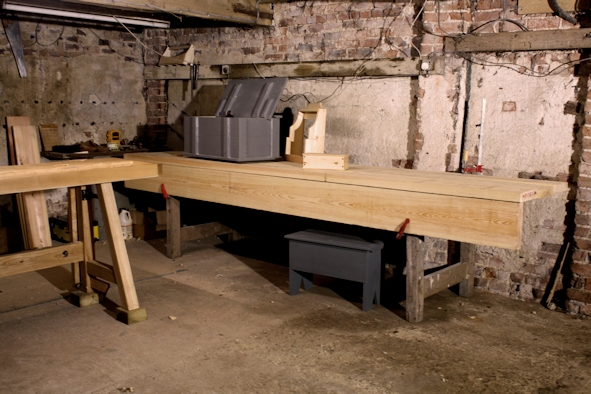 I may tart mine up a little with some extra touches if I get carried away, but ultimately it will be a perfect replica of an old English bench built to the principles and their way of working. I’m hoping that whilst my chosen dimensions will be rather extreme for most, the build itself will give anyone looking to build their own bench a few things to think about. The video isn’t going to be a thorough step by step build along but will cover everything as we go. [EDIT – The video is long. And very detailed. Our plan for this changed before we started the build and after a thorough time on the editing table we will be launching the English bench build as a Premium Video Series.]
I may tart mine up a little with some extra touches if I get carried away, but ultimately it will be a perfect replica of an old English bench built to the principles and their way of working. I’m hoping that whilst my chosen dimensions will be rather extreme for most, the build itself will give anyone looking to build their own bench a few things to think about. The video isn’t going to be a thorough step by step build along but will cover everything as we go. [EDIT – The video is long. And very detailed. Our plan for this changed before we started the build and after a thorough time on the editing table we will be launching the English bench build as a Premium Video Series.]
As a side note we’ve decided to keep the Little John bench in here for the time being. I wondered why Helen was so encouraging of the 12′ length to my new bench but this long bench will mean that the Little John may still be needed; we can’t just plonk my new bench in the middle of the room to allow filming from all angles and so until I build my second one the Little John will play that part. Helen will be learning on it and I’ve made some simple skids so I can raise it up and use it myself as a dedicated joinery / detail bench.
I received a great question in the comments on my last workbench post from Mitchell – “I enjoyed this post, Richard, but it does conjure up what I think is a relative question…it is obvious you think highly of traditional English benches, so why, as you stated, have the vast majority of benches that you have built recently been French?”
Sorry to keep you hanging but I’m going to answer this one in my next post about my workbench.
We take you step by step through a traditional bench build, starting out with a discussion on choosing the ideal dimensions, demonstrations of how to cut the joinery, right through to flattening your workbench top and building the face vice from scratch.If you’d like us to guide you through your build with detailed videos and PDF plans, then you can find full details for this Workbench Series here.

![Simple Work Holding For Ploughing Grooves [Without a Tail Vice]](https://www.theenglishwoodworker.com/wp-content/uploads/2022/07/workholding-without-tail-vice-copy.jpg)
![Gluing Up A Workbench Leg [VIDEO]](https://www.theenglishwoodworker.com/wp-content/uploads/2022/06/gluing-up-a-workbench-leg-video.jpg)
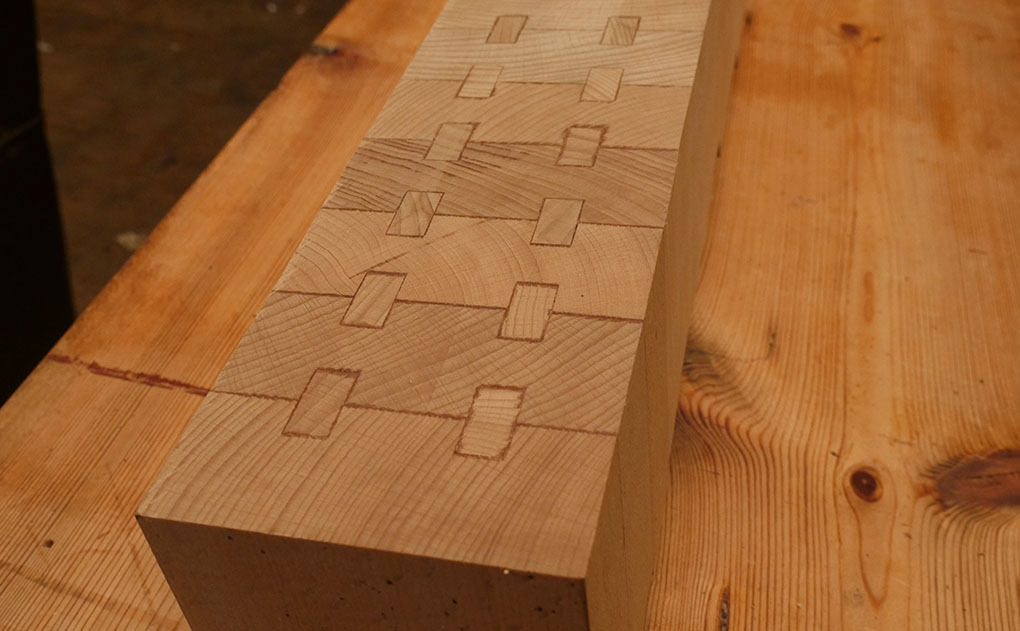
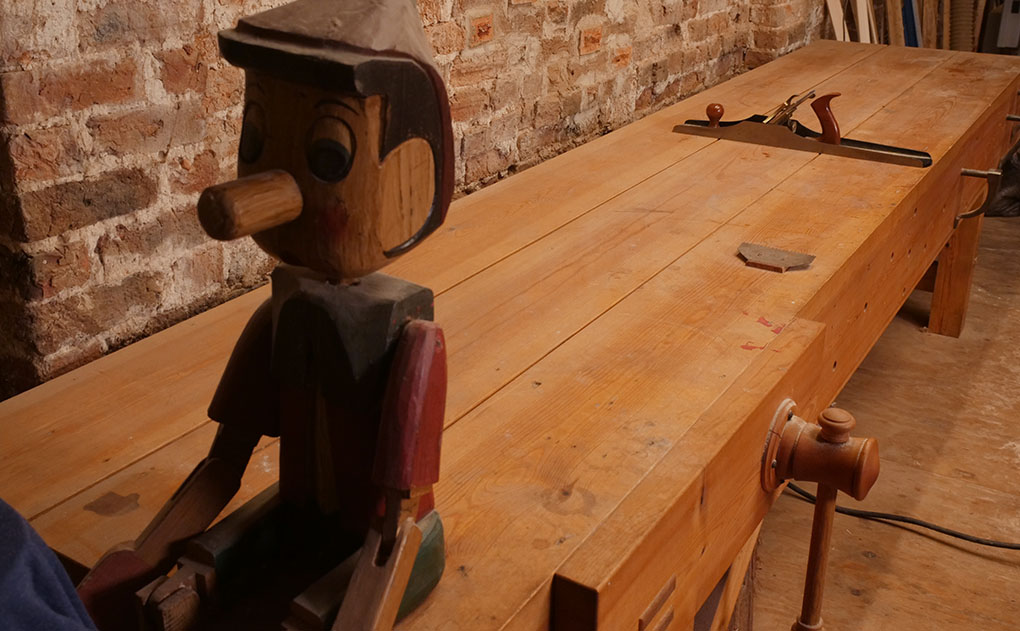
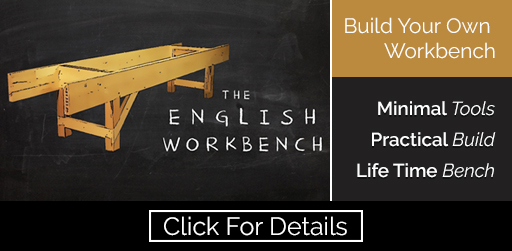
A 12′ bench, I am so jealous of you right now
I’m looking forward to see the build on this bench.
Cool bench. Is there any chance for the top to sag along the back edge with a bench that long?
I love your the English style bench – particularly your design. What’s your timeline for this project. Will you use the angled notch for the apron? Are you going to use a vice or just holdfasts?
Jim
Ive seen the same sort of bench built with the upper edge of the apron board flush with the top of the top. Would you touch on what the pros and cons are for that manner of construction versus building it with the apron board underneath the top as pictured there. I would think that the support it gives to the top would be one thing but surely there are other reasonings behind each of the two methods?
Well at least yours appears to become a proper workbench and not a work table, I have been working on for the past few days. I have been resawing and making an 8 foot bench into a 4 foot one, and a 2/3rd the size in depth of the original.
Yet if we look at the famous plate 11 from Roubo’s book the size of benches that is shown… 12′ one is for a hobbyist.
Hi Richard!
I very much like this part of the post: “(…) but then I received the timber delivery and each board was clearer than most pine you get to see and amazingly straight and free from twist (…)”. That must be fantastic to order “blindly” some kind of timber and get so nice boards delivered. Especially, that it’s not always so easy to find in person such a nice material. Is this kiln dried 2″ stuff?
I understand, that by placing the front top board on the apron, You get a long resting surface, that prevents this one from sagging. Would it be convenient to place another apron on the other side for the same purpose (what ScottV mentioned)? Nicholsons bench doesn’t have one, but it could be of a lesser grade of wood, as it would seldom be seen, but in need You’d also have the symmetry and could use the bench all around.
Kindest regards,
Lukasz.
I also built a English style Nicholson bench. I did stop at 8 foot though. I was told that when building the great houses sometimes they built the benches twenty feet long. Built them onsite and tore them down after the job. I put that trademark diagonal mortise on my legs and I just love it. I have to admit i did use power tools on mine.
Great stuff, your new bench will surpass my measley 10 footer! (English style, pine)Though I have to say, mine has enabled me to do some pretty substantial joinery work. I am sure yours will do the same! Best of luck, I look forward to seeing your video.
Oh, please!
That “how you use it” line was conjured up by some poor sap who was saddled with a itty-bitty…ah…bench. Going for a 12-footer is nothing but compensation, mate, pure compensation.
On the other hand, my new bench is 30-inches long, so what does that say about me? I would prefer you read it as compensation in reverse, but the reality is, after all these years, I have finally conceded to my lot in life, or lack thereof.
If it gets wet will it still be that long
You won’t regret the 12′ bench. I built a 12′ footer out of Southern Yellow Pine 2×6’s. I laminated 30 2x6x12’s together for the top, so it’s rock solid and gives me ample room for any size project I want to build. Thanks for the blog; I enjoy reading it!
Great blog, you have inspired me to de-clutter and although I do not have the space for a 12′ bench I think I will go for a 10′. I never considered building such a large bench but Im now excited about the whole project keeping your advice in mind.